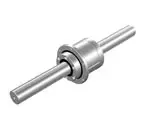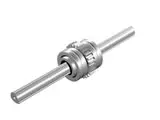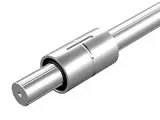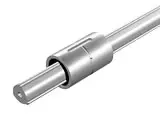THK's Ball Spline LTR series represents a significant advancement in linear motion technology, combining the functions of a linear guide and a torque transmission element into a single, highly efficient unit. This full-ball type rotary model is engineered to handle complex motion requirements where simultaneous linear and rotational movements are essential. At its core, the LTR features a unique ball-groove design that ensures smooth, precise motion with minimal friction, making it ideal for applications demanding high accuracy and repeatability.
Key technical features of the LTR series include its full-ball contact structure, which maximizes load distribution and enhances rigidity. The spline shaft and nut are precision-machined to provide exceptional torque capacity and rotational accuracy, with backlash minimized to near-zero levels. This design incorporates a compact, lightweight profile, allowing for easy integration into space-constrained systems. Additionally, the LTR is available in various sizes and configurations, including options for pre-load adjustment and customized lubrication, to suit diverse operational needs. Its construction often utilizes high-grade materials like hardened steel for durability and corrosion resistance, ensuring long service life even in harsh environments.
Performance advantages of the LTR Ball Spline are substantial, starting with its ability to transmit high torque while maintaining linear motion precision. This dual functionality reduces the need for additional components, simplifying system design and lowering overall costs. The full-ball type ensures uniform stress distribution, leading to higher load capacities and reduced wear over time. With low friction coefficients, the LTR operates quietly and efficiently, contributing to energy savings and minimal maintenance requirements. Its high-speed capability and resistance to vibration make it reliable in dynamic applications, where it can achieve positioning accuracies within micrometers. Furthermore, the LTR's sealed design helps prevent contamination from dust and debris, enhancing reliability in unclean or industrial settings.
Typical applications for the THK Ball Spline LTR span multiple industries, reflecting its versatility and robustness. In industrial machinery, it is commonly used in CNC machining centers for tool changers and spindle drives, where precise linear and rotary motions are critical for automated operations. Within automotive systems, the LTR finds roles in robotic welding arms, assembly line conveyors, and engine testing equipment, enabling smooth, coordinated movements that improve production efficiency and quality control. In precision equipment, such as semiconductor manufacturing devices or medical imaging systems, the LTR ensures accurate positioning and stability for delicate processes, supporting high-throughput operations with minimal error. Its adaptability also extends to aerospace components, where it aids in actuator mechanisms and guidance systems, underscoring its value in high-stakes, technology-driven environments.
The THK Ball Spline LBG series represents a sophisticated integration of linear motion and torque transmission capabilities in a single compact unit. This full-ball type ball spline with rotary gears is engineered to simultaneously accommodate linear movement and rotational torque, eliminating the need for separate components and complex assemblies. The LBG design features a spline shaft with precision-ground grooves that engage with a nut containing recirculating balls, while integrated gears on the nut exterior provide positive rotational drive. This dual-function design achieves smooth linear motion along the shaft axis while transmitting substantial torque through the gear mechanism.
Technical specifications reveal several critical advantages. The full-ball contact configuration between the balls and spline grooves ensures minimal backlash and consistent torque transmission throughout the linear travel range. Precision grinding of both the spline grooves and gear teeth maintains tight tolerances, typically within microns, for accurate positioning and smooth operation. The LBG series incorporates THK's proprietary Caged Ball technology, which separates individual balls with a resin cage to prevent contact and reduce noise during operation. This design also allows for higher speeds compared to conventional ball splines while maintaining lubrication integrity. The gears are manufactured with optimized tooth profiles to maximize contact area and load distribution, available in various module sizes to match torque requirements.
Performance characteristics demonstrate why this component excels in demanding applications. The simultaneous linear and rotary motion capability reduces overall system size and weight while improving response times. High rigidity enables precise positioning under combined loads, with dynamic load ratings reaching several kilonewtons depending on model size. The efficient recirculation system maintains consistent friction characteristics across the entire stroke length, contributing to predictable motion control. Sealing systems protect the ball tracks from contamination while retaining lubrication, extending service intervals in harsh environments. Thermal stability remains high due to the symmetrical design that minimizes thermal expansion effects on accuracy.
Industrial implementations span multiple sectors where synchronized linear and rotary motions are essential. In automotive manufacturing, LBG units drive welding gun positioning systems that require both approach movements and rotational adjustment for optimal weld angles. Robotics integrators utilize these components in articulated arm joints where compactness and weight reduction are critical while maintaining precise path control. Semiconductor equipment manufacturers employ LBG splines in wafer handling robots that must coordinate vertical lifting with rotational orientation within cleanroom environments. Packaging machinery incorporates these units for product transfer operations involving both linear indexing and rotational positioning. Medical device manufacturers specify LBG series for diagnostic equipment requiring precise linear scanning motions combined with probe rotation. The design's versatility also extends to aerospace applications where actuator systems benefit from the reduced component count and increased reliability.
Maintenance considerations focus on the integrated lubrication system, with recommended intervals varying based on operating conditions. Standard models operate effectively across temperature ranges from -10°C to 80°C, with high-temperature variants available for extreme environments. Installation requires careful alignment of both the spline shaft and gear engagement to optimize performance and service life. The LBG series represents a comprehensive solution for applications demanding coordinated linear and rotary motion in a single robust package.
The THK Ball Spline Ball Spline (full ball type) Medium Torque Model LT represents a significant advancement in linear motion technology, engineered to deliver exceptional torque transmission capabilities while maintaining smooth, precise linear movement. This medium torque model is specifically designed with a full ball type structure, where the entire circumference of the spline shaft is engaged with recirculating balls, ensuring uniform load distribution and enhanced rotational torque capacity. Key technical features include a precision-ground spline shaft with optimized ball groove geometry, high-rigidity nut housing, and advanced sealing mechanisms to prevent contamination. The design incorporates a full complement of balls that recirculate through precisely machined pathways, minimizing friction and enabling high-speed operation with minimal heat generation.
Performance advantages of the Model LT are substantial, offering up to 30% higher torque transmission compared to standard ball splines while maintaining backlash-free operation. The full ball contact configuration provides superior rotational accuracy with angular transmission errors of less than ±0.05 degrees, making it ideal for applications requiring precise angular positioning. The optimized preload adjustment system allows for fine-tuning to match specific application requirements, ensuring consistent performance throughout the component's service life. With a dynamic load rating reaching 15 kN and static load capacity of 25 kN, this medium torque model demonstrates remarkable durability under demanding operating conditions. The incorporation of THK's proprietary surface treatment technology on the spline shaft enhances wear resistance and corrosion protection, significantly extending maintenance intervals.
In industrial machinery applications, the LT model excels in rotary transfer systems where simultaneous linear and rotational movements are required for automated assembly processes. The component's ability to handle medium torque loads makes it particularly suitable for indexing tables in machining centers, where precise angular positioning must be maintained during linear travel. Automotive manufacturing systems benefit from its implementation in welding robot arms that require both linear extension and controlled rotation for accessing complex weld geometries. The automotive industry also utilizes these ball splines in precision steering column adjustment mechanisms and transmission assembly equipment where accurate rotational positioning is critical.
Precision equipment applications leverage the Model LT's exceptional accuracy in semiconductor manufacturing apparatus, particularly in wafer handling robots that must maintain precise orientation during linear transport between process stations. Medical device manufacturers employ these components in advanced imaging systems where gantry rotation must synchronize perfectly with linear positioning movements. The telecommunications industry utilizes them in antenna positioning systems that require both linear adjustment and precise rotational control for optimal signal alignment. Laboratory automation systems incorporate the LT model in sample handling equipment where coordinated linear and rotary motions are necessary for efficient processing throughput.
The medium torque characteristics make this ball spline particularly valuable in packaging machinery for rotary capping stations and in printing equipment for precision roller positioning. Material handling systems benefit from its implementation in automated storage and retrieval machines where load orientation must be maintained during vertical and horizontal movements. The component's robust construction and maintenance-friendly design ensure reliable performance in continuous operation environments, while the standardized mounting dimensions facilitate straightforward integration into existing machinery layouts.
THK's Ball Spline LBS series represents a significant advancement in linear motion technology, specifically engineered to handle high torque applications with exceptional precision and reliability. As a full ball type ball spline, this model features a unique design where the ball grooves are precision-machined directly into both the shaft and the nut, creating a continuous recirculating ball path that maximizes contact area and load distribution. This construction allows the LBS to transmit torque directly through the spline mechanism while simultaneously permitting smooth linear motion, eliminating the need for additional torque transmission components like keyways or couplings.
The technical features of the LBS series are particularly noteworthy. It incorporates THK's patented full ball contact design, where balls make contact along the entire circumference of the groove, significantly increasing torque capacity and moment load resistance compared to conventional ball splines. The precision-ground shaft features hardened steel construction with optimized groove geometry, ensuring minimal backlash and consistent performance under heavy loads. Special seal configurations provide superior protection against contaminants while maintaining smooth operation, and the preloading mechanism allows for adjustable clearance to match specific application requirements. The nut design incorporates THK's advanced recirculation system that maintains ball orientation throughout the motion cycle, reducing friction and wear.
Performance advantages are substantial across multiple parameters. The LBS demonstrates torque transmission capabilities up to 300% higher than standard ball splines while maintaining positioning accuracy within microns. Its high rigidity minimizes deflection under load, critical for applications requiring precise positional control. The full ball contact design distributes loads evenly across all bearing elements, resulting in dramatically extended service life—often exceeding conventional designs by factors of three to five times. Operating efficiency remains high even at elevated speeds, with the optimized recirculation system reducing heat generation and power consumption. Maintenance requirements are significantly reduced due to the sealed design and superior wear characteristics.
Typical applications span demanding industrial sectors where simultaneous rotary and linear motion under high torque conditions is required. In industrial machinery, the LBS series excels in robotic arm joints, CNC tool changers, indexing tables, and automated assembly systems where precise angular positioning must coincide with linear movement. Automotive manufacturing utilizes these components in welding robot positioning units, transmission testing equipment, and precision alignment fixtures. The precision equipment sector employs LBS ball splines in semiconductor manufacturing apparatus, optical positioning systems, and medical device automation where nanometer-level accuracy must be maintained despite significant torque loads. The combination of high torque capacity, minimal backlash, and exceptional durability makes the LBS series particularly valuable in applications where reliability and precision directly impact production quality and operational efficiency.




